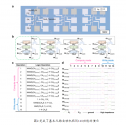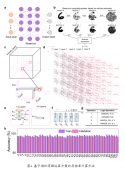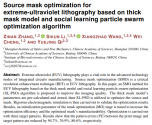Ren Tianling's team from the School of Integrated Circuits proposed a solution for integrating cellular automata algorithms into a two-dimensional transistor and memristor hybrid circuit.
Tsinghua News Network, May 17th. The team of Professor Ren Tianling from the School of Integrated Circuits of Tsinghua University proposed to integrate the cellular automata algorithm into a two-dimensional transistor and memristor hybrid circuit, and based on this architecture, proposed a reserve pool calculation function based on this circuit.
Cellular automata is an effective method for studying the dynamics of complex systems, and it is a ubiquitous and massively parallel computing model proposed by von Neumann. The main methods of hardware implementation of cellular automata include very large scale integration (VLSI) and field programmable gate array (FPGA). The circuit configuration of VLSI is fixed, which limits the flexibility of converting different cellular automata conversion rules, while FPGA allows circuit reconfiguration, but it leads to higher hardware cost. Therefore, hardware implementations of cellular automata require new designs to ensure low cost and high flexibility. In recent years, memristor circuits have become an ideal solution for realizing in-memory computing due to their low-cost and high-performance characteristics. The basic operations of memristor arrays are mainly matrix multiplication and accumulation calculations or logic operations, and the conversion rules of cellular automata can be converted into corresponding Boolean functions, which provides a good platform for memristor circuits to realize the conversion rules of cellular automata .
In this study, the memristor and the two-dimensional material transistor are combined to complete the circuit design, and a circular logic operation scheme is proposed, so that the hardware realizes the cellular automata algorithm. The solution combines the storage and computing functions of the memristor, and the transmission is cyclic inside the memristor, which minimizes the hardware cost. The functional demonstration of the basic cellular automaton No. 110 was completed in the research. The iterative update is performed by decomposing the transfer rules of the cellular automaton into the memory operation of the memristor.
The research team also verified the majority classification algorithm and edge detection algorithm of cellular automata in the circular logic operation scheme. Especially for the edge detection algorithm, the hardware cost of the circular logic operation scheme based on cellular automata can be reduced by up to 79 times compared with FPGA implementation. In addition, the research also proposes a storage library computing method based on a circular logic operation scheme, which can optimize the data handling process, and further combine with a multi-layer memristor array to minimize the data handling consumption in the storage pool calculation. This research explores new possibilities for the subsequent application of memristors, and points out that the cellular automata algorithm can be realized with low hardware cost through memristor arrays, which has potential application value in fields such as edge detection computing.


Tsinghua News Network, May 17th. The team of Professor Ren Tianling from the School of Integrated Circuits of Tsinghua University proposed to integrate the cellular automata algorithm into a two-dimensional transistor and memristor hybrid circuit, and based on this architecture, proposed a reserve pool calculation function based on this circuit.
Cellular automata is an effective method for studying the dynamics of complex systems, and it is a ubiquitous and massively parallel computing model proposed by von Neumann. The main methods of hardware implementation of cellular automata include very large scale integration (VLSI) and field programmable gate array (FPGA). The circuit configuration of VLSI is fixed, which limits the flexibility of converting different cellular automata conversion rules, while FPGA allows circuit reconfiguration, but it leads to higher hardware cost. Therefore, hardware implementations of cellular automata require new designs to ensure low cost and high flexibility. In recent years, memristor circuits have become an ideal solution for realizing in-memory computing due to their low-cost and high-performance characteristics. The basic operations of memristor arrays are mainly matrix multiplication and accumulation calculations or logic operations, and the conversion rules of cellular automata can be converted into corresponding Boolean functions, which provides a good platform for memristor circuits to realize the conversion rules of cellular automata .
In this study, the memristor and the two-dimensional material transistor are combined to complete the circuit design, and a circular logic operation scheme is proposed, so that the hardware realizes the cellular automata algorithm. The solution combines the storage and computing functions of the memristor, and the transmission is cyclic inside the memristor, which minimizes the hardware cost. The functional demonstration of the basic cellular automaton No. 110 was completed in the research. The iterative update is performed by decomposing the transfer rules of the cellular automaton into the memory operation of the memristor.
The research team also verified the majority classification algorithm and edge detection algorithm of cellular automata in the circular logic operation scheme. Especially for the edge detection algorithm, the hardware cost of the circular logic operation scheme based on cellular automata can be reduced by up to 79 times compared with FPGA implementation. In addition, the research also proposes a storage library computing method based on a circular logic operation scheme, which can optimize the data handling process, and further combine with a multi-layer memristor array to minimize the data handling consumption in the storage pool calculation. This research explores new possibilities for the subsequent application of memristors, and points out that the cellular automata algorithm can be realized with low hardware cost through memristor arrays, which has potential application value in fields such as edge detection computing.





